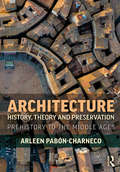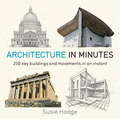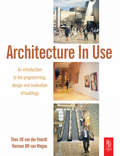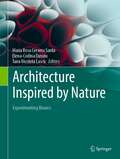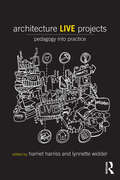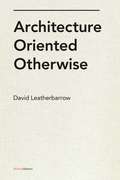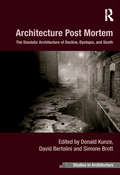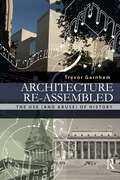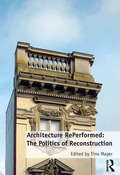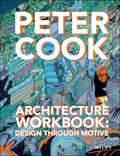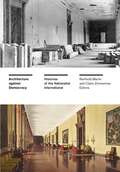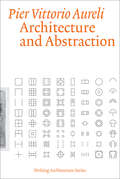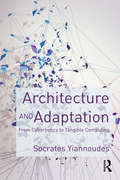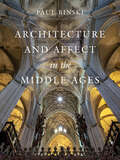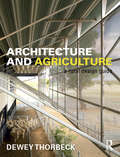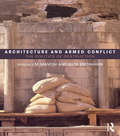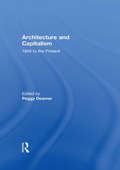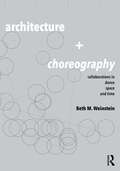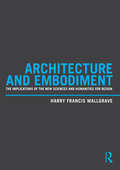- Table View
- List View
Architecture History, Theory and Preservation: Prehistory to the Middle Ages
by Arleen Pabón-CharnecoArchitecture History, Theory and Preservation critically explores the historic development, theoretical underpinnings and conservation practices of architecture. Complete with 170 full color images, this volume presents architectural and urban examples, from Prehistory to the Middle Ages, chronologically and thematically examining contextual issues that provide each period with distinctive expressions. The special features, structural systems, materials and construction technologies are analyzed, as well as how the international community deals with the task of interpreting and preserving certain historic properties. This publication provides professors and students of architecture, art history, historic preservation and related fields with an integrated view of architecture using historical, theoretical and conservation perspectives. As an architect, architectural historian and preservationist herself, Dr Pabón-Charneco weaves a field of relationships regarding each building, creating a silent yet empowering bridge between past and present.
Architecture In Minutes
by Susie HodgeIn this hyper-compact, fully illustrated guide to architecture, Susie Hodge outlines the history and theory of architecture from the earliest structures to the cutting-edge concepts of the present day. Along the way she profiles 200 key buildings, historic styles, architectural movements and celebrated architects from all around the world. Contents include theGreek orders, Roman engineering, Gothic architecture, the Renaissance, the Baroque, Revivalism, Art Nouveau, Modernism and Postmodernism, Futurism and Dynamic architecture along with architects like Inigo Jones, Christopher Wren, Gaudi, Frank Lloyd Wright, Le Corbusier and Frank Gehry.
Architecture In Minutes (IN MINUTES)
by Susie HodgeIn this hyper-compact, fully illustrated guide to architecture, Susie Hodge outlines the history and theory of architecture from the earliest structures to the cutting-edge concepts of the present day. Along the way she profiles 200 key buildings, historic styles, architectural movements and celebrated architects from all around the world. Contents include the Greek orders, Roman engineering, Gothic architecture, the Renaissance, the Baroque, Revivalism, Art Nouveau, Modernism and Postmodernism, Futurism and Dynamic architecture along with architects like Inigo Jones, Christopher Wren, Gaudi, Frank Lloyd Wright, Le Corbusier and Frank Gehry.
Architecture In Use
by DJM van der Voordt HBR van WegenThis unique book discusses programming, design and building evaluation providing a ‘joined up’ approach to building design. By linking the functional and architectonic qualities of a building, the authors show the practical implications of the utility value of buildings. Starting by looking at how the relationship between form and function has been dealt with by different approaches to architecture from a historical perspective, it goes on to discuss how the desired functional quality and utility value of a building can be expressed in a brief and given a physical form by the architect. Finally, it advises on how to carry out post-occupancy evaluation and provides the architect with methods and techniques for testing whether the intended utility value of a building has been achieved.
Architecture Inspired by Nature: Experimenting Bionics
by María Rosa Cervera Sardá Elena-Codina Dușoiu Tana Nicoleta LascuThe book brings together the research completed during 10 editions of International Seminars of Bionics, organized by the School of Architecture of the University of Alcalá de Henares, Madrid, several of them in partnership with the “Ion Mincu” University of Architecture and Urbanism, Bucharest, carried out in Spain and in Romania. The articles here consider advanced bionic design principles, implementing them to an impressive variety of application fields, including, but not limited to, urban planning and landscape, public space, architecture and building structures, design and detailing, application of natural dynamic processes, bio-digital architecture, innovative materials based on living organisms (micro-algae), and nano-modified materials. A particular focus is given to light and perception of light. To illustrate the principles developed, this contributed volume includes descriptions and full-color images of the experimental projects created during the workshops held in the framework of these ISB meetings: Learning from Nature, Integrating Bionics (2009); Adaptability, Efficiency and Biostructures (2010); Bionics and Innovation (2011); Forms and Structures Inspired by Nature (2016, 2017); Furniture Inspired by Natural Models (2018); Relation between Structure and Envelope: Light Structures (2019); Light, from Nature to Architecture. Structures Inspired in Nature (2020); Light in Architecture and Design: A Bionic Perspective (2021); Sustainable Thinking and Bionics (2022).
Architecture Live Projects: Pedagogy into Practice
by Harriet Harriss Lynnette WidderArchitecture Live Projects provides a persuasive, evidence-based advocacy for moving a particular kind of architectural learning, known as Live Projects, towards a holistic integration into current and future architectural curricula. Live Projects are work completed in the borderlands between architectural education and built environment practice; they include design/build work, community-based design, urban advocacy consulting and a host of other forms and models described by the book’s international group of authors. Because of their position, Live Projects as vehicle for simultaneously providing teaching and service has the potential to recalibrate the contesting claims that both academia and profession make to architecture. This collection of essays and case studies consolidates current discussions on theory and learning ambitions, academic best practices, negotiation with licensure and accreditation, and considerations of architectural integrity. It is an invaluable resource to current and future Live Projects advocates – whether they aim to move from pedagogy into practice or practice into pedagogy.
Architecture Matters
by Aaron BetskyAn illuminating introduction to the influence of architecture on the world, the environment, and human lives Architecture matters. It matters to cities, the planet, and human lives. How architects design and what they build has an impact that usually lasts for generations. The more we understand architecture—the deeper we probe the decisions and designs that go into making a building—the better our world becomes. Aaron Betsky, architect, author, curator, former museum director, and currently the dean of the Frank Lloyd Wright School of Architecture, guides readers into the rich and complex world of contemporary architecture. Combining his early experiences as an architect with his extensive experience as a jury member selecting the world’s most prominent and cutting-edge architects to build icons for cities, Betsky possesses rare insight into the mechanisms, politics, and personalities that play a role in how buildings in our societies and urban centers come to be. In approximately fifty themes, drawing on his inside knowledge of the architectural world, he explores a broad spectrum of topics, from the meaning of domestic space to the spectacle of the urban realm. Accessible, instructive, and hugely enjoyable, Why Architecture Matters will open the eyes of anyone dreaming of becoming an architect, and will bring a wry smile to anyone who already is.
Architecture Oriented Otherwise
by David Leatherbarrow<p>So much writing about architecture tends to evaluate it on the basis of its intentions: how closely it corresponds to the artistic will of the designer, the technical skills of the builder, or whether it reflects the spirit of the place and time in which it was built, making it not much more than the willful (or even subconscious) assemblage of objects that result from design and construction techniques. <p>Renowned writer and thinker David Leatherbarrow, in this groundbreaking new book, argues for a richer and more profound, but also simpler, way of thinking about architecture, namely on the basis of how it performs. Not simply how it functions, but how it acts, "its manner of existing in the world," including its effects on the observers and inhabitants of a building as well as on the landscape that situates it. In the process, Leatherbarrow transforms our way of discussing buildings from a passive technical or programmatic assessment to a highly active and engaged examination of the lives and performances, intended and otherwise, of buildings.</p>
Architecture Post Mortem: The Diastolic Architecture of Decline, Dystopia, and Death (Ashgate Studies In Architecture Ser.)
by Donald Kunze David Bertolin Simone BrottArchitecture Post Mortem surveys architecture’s encounter with death, decline, and ruination following late capitalism. As the world moves closer to an economic abyss that many perceive to be the death of capital, contraction and crisis are no longer mere phases of normal market fluctuations, but rather the irruption of the unconscious of ideology itself. Post mortem is that historical moment wherein architecture’s symbolic contract with capital is put on stage, naked to all. Architecture is not irrelevant to fiscal and political contagion as is commonly believed; it is the victim and penetrating analytical agent of the current crisis. As the very apparatus for modernity’s guilt and unfulfilled drives-modernity’s debt-architecture is that ideological element that functions as a master signifier of its own destruction, ordering all other signifiers and modes of signification beneath it. It is under these conditions that architecture theory has retreated to an 'Alamo' of history, a final desert outpost where history has been asked to transcend itself. For architecture’s hoped-for utopia always involves an apocalypse. This timely collection of essays reformulates architecture’s relation to modernity via the operational death-drive: architecture is but a passage between life and death. This collection includes essays by Kazi K. Ashraf, David Bertolini, Simone Brott, Peggy Deamer, Didem Ekici, Paul Emmons, Donald Kunze, Todd McGowan, Gevork Hartoonian, Nadir Lahiji, Erika Naginski, and Dennis Maher.
Architecture Re-assembled: The Use (and Abuse) of History
by Trevor GarnhamBeginning from the rise of modern history in the eighteenth century, this book examines how changing ideas in the discipline of history itself has affected architecture from the beginning of modernity up to the present day. It reflects upon history in order to encourage and assist the reader in finding well-founded principles for architectural design. This is not simply another history of architecture, nor a ‘history of histories’. Setting buildings in their contemporaneous ideas about history, it spans from Fischer von Erlach to Venturi and Rossi, and beyond to architects working in the fallout from both the Modern Movement – Aalto, Louis Kahn, Aldo van Eyck – and Post-modernism – such as Rafael Moneo and Peter Zumthor. It shows how Soane, Schinkel and Stirling, amongst others, made a meaningful use of history and contrasts this with how a misreading of Hegel has led to an abuse of history and an uncritical flight to the future. This is not an armchair history but a lively discussion of our place between past and future that promotes thinking for making.
Architecture RePerformed: The Politics Of Reconstruction
by Tino MagerFirst emerging at the beginning of the twentieth century, architectural reconstruction has increasingly become an instrument to visually revive a long bygone past. This book deals with the phenomenon of meticulous reconstruction in architecture. It argues that the politics of reconstruction go far beyond aesthetic considerations. Taking architecture as a major source of history and regional identity, the impact of large-scale reconstruction is deeply intertwined with political and social factors. Furthermore, memories and associations correlated with lost buildings of a bygone era are heavily influenced by their re-appearance, something which often contradicts historical events. Reconstruction has become an established way of building and dealing with the past, yet so far, there is no comprehensive scientific study on it. By bringing together eight case studies from Eastern Europe, France, Spain, China, Japan, Israel and Brazil, it provides valuable insights into this topic. The chapters analyse the political background of the reconstructions and identify the protagonists. In doing so, this volume adds to our understanding of the impact of reconstruction to memory and oblivion, as well as the critical power of reconstruction regarding contemporary architecture and urbanism.
Architecture Workbook: Design through Motive
by Peter CookOrganised into 9 parts that highlight a wide range of architectural motives, such as 'Architecture as Theatre', 'Stretching the Vocabulary' and 'The City of Large and Small', the workbook provides inspiring key themes for readers to take their cue from when initiating a design. Motives cover a wide-range of work that epitomise the theme. These include historical and Modernist examples, things observed in the street, work by current innovative architects and from Cook's own rich archive, weaving together a rich and vibrant visual scrapbook of the everyday and the architectural, and past and present.
Architecture against Democracy: Histories of the Nationalist International
by Claire Zimmerman Reinhold MartinExamining architecture&’s foundational role in the repression of democracy Reinhold Martin and Claire Zimmerman bring together essays from an array of scholars exploring the troubled relationship between architecture and antidemocratic politics. Comprising detailed case studies throughout the world spanning from the early nineteenth century to the present, Architecture against Democracy analyzes crucial occasions when the built environment has been harnessed as an instrument of authoritarian power. Alongside chapters focusing on paradigmatic episodes from twentieth-century German and Italian fascism, the contributors examine historic and contemporary events and subjects that are organized thematically, including the founding of the Smithsonian Institution, Ellis Island infrastructure, the aftermath of the Paris Commune, Cold War West Germany and Iraq, Frank Lloyd Wright&’s domestic architecture, and Istanbul&’s Taksim Square. Through the range and depth of these accounts, Architecture against Democracy presents a selective overview of antidemocratic processes as they unfold in the built environment throughout Western modernity, offering an architectural history of the recent &“nationalist international.&” As new forms of nationalism and authoritarian rule proliferate across the globe, this timely collection offers fresh understandings of the role of architecture in the opposition to democracy. Contributors: Esra Akcan, Cornell U; Can Bilsel, U of San Diego; José H. Bortoluci, Getulio Vargas Foundation; Charles L. Davis II, U of Texas at Austin; Laura diZerega; Eve Duffy, Duke U; María González Pendás, Cornell U; Paul B. Jaskot, Duke U; Ana María León, Harvard U; Ruth W. Lo, Hamilton College; Peter Minosh, Northeastern U; Itohan Osayimwese, Brown U; Kishwar Rizvi, Yale U; Naomi Vaughan; Nader Vossoughian, New York Institute of Technology and Columbia U; Mabel O. Wilson, Columbia U.
Architecture and Abstraction (Writing Architecture)
by Pier Vittorio AureliA landmark study of abstraction in architectural history, theory, and practice that challenges our assumptions about the meaning of abstract forms.In this theoretical study of abstraction in architecture—the first of its kind—Pier Vittorio Aureli argues for a reconsideration of abstraction, its meanings, and its sources. Although architects have typically interpreted abstraction in formal terms—the purposeful reduction of the complexities of design to its essentials—Aureli shows that abstraction instead arises from the material conditions of building production. In a lively study informed by Walter Benjamin, Karl Marx, Alfred Sohn-Rethel, and other social theorists, this book presents abstraction in architecture not as an aesthetic tendency but as a movement that arises from modern divisions of labor and consequent social asymmetries. These divisions were anticipated by the architecture of antiquity, which established a distinction between manual and intellectual labor, and placed the former in service to the latter. Further abstractions arose as geometry, used for measuring territories, became the intermediary between land and money and eventually produced the logic of the grid. In our own time, architectural abstraction serves the logic of capitalism and embraces the premise that all things can be exchanged—even experience itself is a commodity. To resist this turn, Aureli seeks a critique of architecture that begins not by scaling philosophical heights, but by standing at the ground level of material practice.
Architecture and Adaptation: From Cybernetics to Tangible Computing
by Socrates YiannoudesArchitecture and Adaptation discusses architectural projects that use computational technology to adapt to changing conditions and human needs. Topics include kinetic and transformable structures, digitally driven building parts, interactive installations, intelligent environments, early precedents and their historical context, socio-cultural aspects of adaptive architecture, the history and theory of artificial life, the theory of human-computer interaction, tangible computing, and the social studies of technology. Author Socrates Yiannoudes proposes tools and frameworks for researchers to evaluate examples and tendencies in adaptive architecture. Illustrated with more than 50 black and white images.
Architecture and Affect in the Middle Ages (Franklin D. Murphy Lectures)
by Paul BinskiHow did people living in the Middle Ages respond to spectacular buildings, such as the Gothic cathedrals? While contemporary scholarship places a large emphasis on the emotional content of Western medieval figurative art, the emotion of architecture has largely gone undiscussed. In a radical new approach, Architecture and Affect in the Middle Ages explores the relationship between medieval buildings and the complexity of experience they engendered. Paul Binski examines long-standing misconceptions about the way viewers responded to medieval architecture across Western Europe and in Byzantine and Arabic culture between late antiquity and the end of the medieval period. He emphasizes the importance of the experience itself within these built environments, essentially places of action, space, and structure but also, crucially, of sound and emotion.
Architecture and Affect: Precarious Spaces (Routledge Research in Architecture)
by Lilian CheeArchitecture and Affect is motivated by two questions: Why does dismissed affective evidence trouble us? What would it mean for architecture to assemble such discrepant evidence into its discourse? Arguing that the persistent refrains of lived affect dwell in architecture, this book traces such refrains to a concept of architecture wedged in the middle ground—jammed amidst life, things and events. Rather than being aloof from its surrounds, architecture-in-the-midst challenges an autonomous epistemology. Beyond accounting for the vivid but excluded, this book develops a frame and a disposition for thinking critically about, speculatively through, and being grounded by, encounter. Examining affect through a constellation of spaces in contemporary Singapore, it details architecture’s uneasy but inextricable relationship with key subjects relegated to the incommensurate, the peripheral, the scenic and the decorative. The outcome is a politicized architectural discourse simultaneously grounded and speculative; bridging depth and intuition, thinking and feeling.
Architecture and Agriculture: A Rural Design Guide
by Dewey ThorbeckArchitecture and Agriculture: A Rural Design Guide presents architectural guidelines for buildings designed and constructed in rural landscapes by emphasizing their connections with function, culture, climate, and place. Following on from the author’s first book Rural Design, the book discusses in detail the buildings that humans construct in support of agriculture. By examining case studies from around the world including Australia, China, Japan, Norway, Poland, Japan, Portugal, North America, Africa and the Southeast Asia it informs readers about the potentials, opportunities, and values of rural architecture, and how they have been developed to create sustainable landscapes and sustainable buildings for rapidly changing rural futures.
Architecture and Armed Conflict: The Politics of Destruction
by Keith Bresnahan J. M. ManciniArchitecture and Armed Conflict is the first multi-authored scholarly book to address this theme from a comparative, interdisciplinary perspective. By bringing together specialists from a range of relevant fields, and with knowledge of case studies across time and space, it provides the first synthetic body of research on the complex, multifaceted subject of architectural destruction in the context of conflict. The book addresses several specific research questions: How has the destruction of buildings and landscapes figured in recent historical conflicts, and how have people and states responded to it? How has the destruction of architecture been represented in different historical periods, and to what ends? What are the relationships between the destruction of architecture and the destruction of art, particularly iconoclasm? If architectural destruction is a salient feature of many armed conflicts, how does it feature in post-conflict environments? What are the relationships between architectural destruction and processes of restoration, recreation or replacement? Considering multiple conflicts, multiple time periods, and multiple locations allows this international cohort of authors to provide an essential primer for this crucial topic.
Architecture and Capitalism: 1845 to the Present
by Peggy DeamerArchitecture and Capitalism tells a story of the relationship between the economy and architectural design. Eleven historians each discuss in brand new essays the time period they know best, looking at cultural and economic issues, which in light of current economic crises you will find have dealt with diverse but surprisingly familiar economic issues. Told through case studies, the narrative begins in the mid-nineteenth century and ends with 2011, with introductions by Editor Peggy Deamer to pull the main themes together so that you can see how other architects in different times and in different countries have dealt with similar economic conditions. By focussing on what previous architects experienced, you have the opportunity to avoid repeating the past. With new essays by Pier Vittorio Aureli, Ellen Dunham-Jones, Keller Easterling, Lauren Kogod, Robert Hewison, Joanna Merwood-Salisbury, Robin Schuldenfrei, Deborah Gans, Simon Sadler, Nathan Rich, and Micahel Sorkin.
Architecture and Choreography: Collaborations in Dance, Space and Time
by Beth WeinsteinArchitecture and Choreography: Collaborations in Dance, Space and Time examines the field of archi-choreographic experiments—unique interdisciplinary encounters and performed events generated through collaborations between architects and choreographers.Forty case studies spanning four decades give evidence of the range of motivations for embarking on these creative endeavors and diverse conceptual underpinnings, generative methods, objects of inquiry, and outcomes. Architecture and Choreography builds histories and theories through which to examine these works, the contexts within, and processes through which the works emerged, and the critical questions they raise about ways to work together, sites and citations, ethics and equity, control and agency. Three themes frame pairs of chapters. The first addresses disciplinarity through works that critically reflect upon their discipline’s tools, techniques, and conventions juxtaposed against projects that cite or use other art forms and cultural phenomena as source material. The second interrogates space and the role of spatial dispositifs, institutions, and sites, and their hidden and not-so-hidden conditions, as conceptual drivers and structures to subvert, trouble, unsettle, remember. The third asks who and what dances, finding a spectrum from mobilized architectural bodies to more-than-human cybarcorps. Modes of collaboration and the temporalities and life cycles of projects inform bookending chapters.Architecture and Choreography offers vital lessons not only for architects and choreographers but also for students and practitioners across design and performance fields.
Architecture and Collective Life
by Penny LewisThis book addresses the complex relationship between architecture and public life. It’s a study of architecture and urbanism as cultural activity that both reflects and gives shape to our social relations, public institutions and political processes. Written by an international range of contributors, the chapters address the intersection of public life and the built environment around the themes of authority and planning, the welfare state, place and identity and autonomy. The book covers a diverse range of material from Foucault’s evolving thoughts on space to land-scraping leisure centres in inter-war Belgium. It unpacks concepts such as ‘community’ and ‘collectivity’ alongside themes of self-organisation and authorship. Architecture and Collective Life reflects on urban and architectural practice and historical, political and social change. As such this book will be of great interest to students and academics in architecture and urbanism as well as practicing architects.
Architecture and Construction in Steel
by Alan Blanc Michael McEvoy Roger PlankThis book provides a comprehensive guide to the successful use of steel in building and will form a unique source of inspiration and reference for all those concerned with architecture in steel.
Architecture and Embodiment: The Implications of the New Sciences and Humanities for Design
by Harry Francis MallgraveIn recent years we have seen a number of dramatic discoveries within the biological and related sciences. Traditional arguments such as "nature versus nurture" are rapidly disappearing because of the realization that just as we are affecting our environments, so too do these altered environments restructure our cognitive abilities and outlooks. If the biological and technological breakthroughs are promising benefits such as extended life expectancies, these same discoveries also have the potential to improve in significant ways the quality of our built environments. This poses a compelling challenge to conventional architectural theory... This is the first book to consider these new scientific and humanistic models in architectural terms. Constructed as a series of five essays around the themes of beauty, culture, emotion, the experience of architecture, and artistic play, this book draws upon a broad range of discussions taking place in philosophy, psychology, biology, neuroscience, and anthropology, and in doing so questions what implications these discussions hold for architectural design. Drawing upon a wealth of research, Mallgrave argues that we should turn our focus away from the objectification of architecture (treating design as the creation of objects) and redirect it back to those for whom we design: the people inhabiting our built environments.
Architecture and Empire in Jamaica
by Louis NelsonThrough Creole houses and merchant stores to sugar fields and boiling houses, Jamaica played a leading role in the formation of both the early modern Atlantic world and the British Empire. Architecture and Empire in Jamaica offers the first scholarly analysis of Jamaican architecture in the long 18th century, spanning roughly from the Port Royal earthquake of 1692 to Emancipation in 1838. In this richly illustrated study, which includes hundreds of the author's own photographs and drawings, Louis P. Nelson examines surviving buildings and archival records to write a social history of architecture.  Nelson begins with an overview of the architecture of the West African slave trade then moves to chapters framed around types of buildings and landscapes, including the Jamaican plantation landscape and fortified houses to the architecture of free blacks. He concludes with a consideration of Jamaican architecture in Britain. By connecting the architecture of the Caribbean first to West Africa and then to Britain, Nelson traces the flow of capital and makes explicit the material, economic, and political networks around the Atlantic. Â
